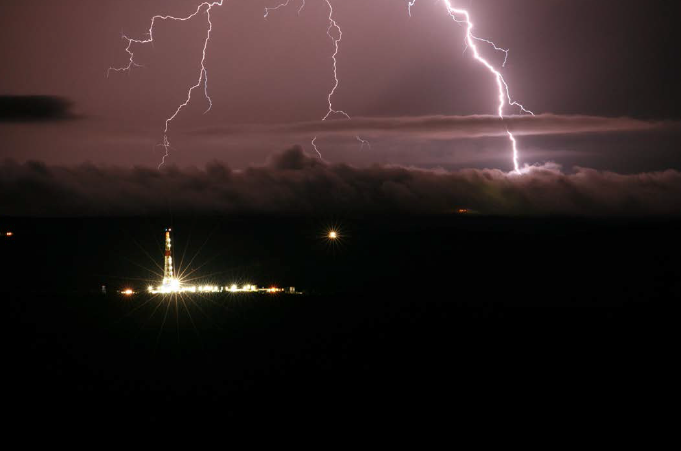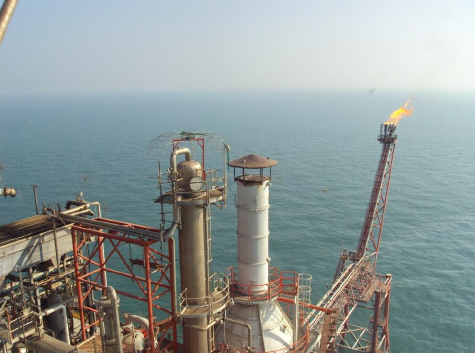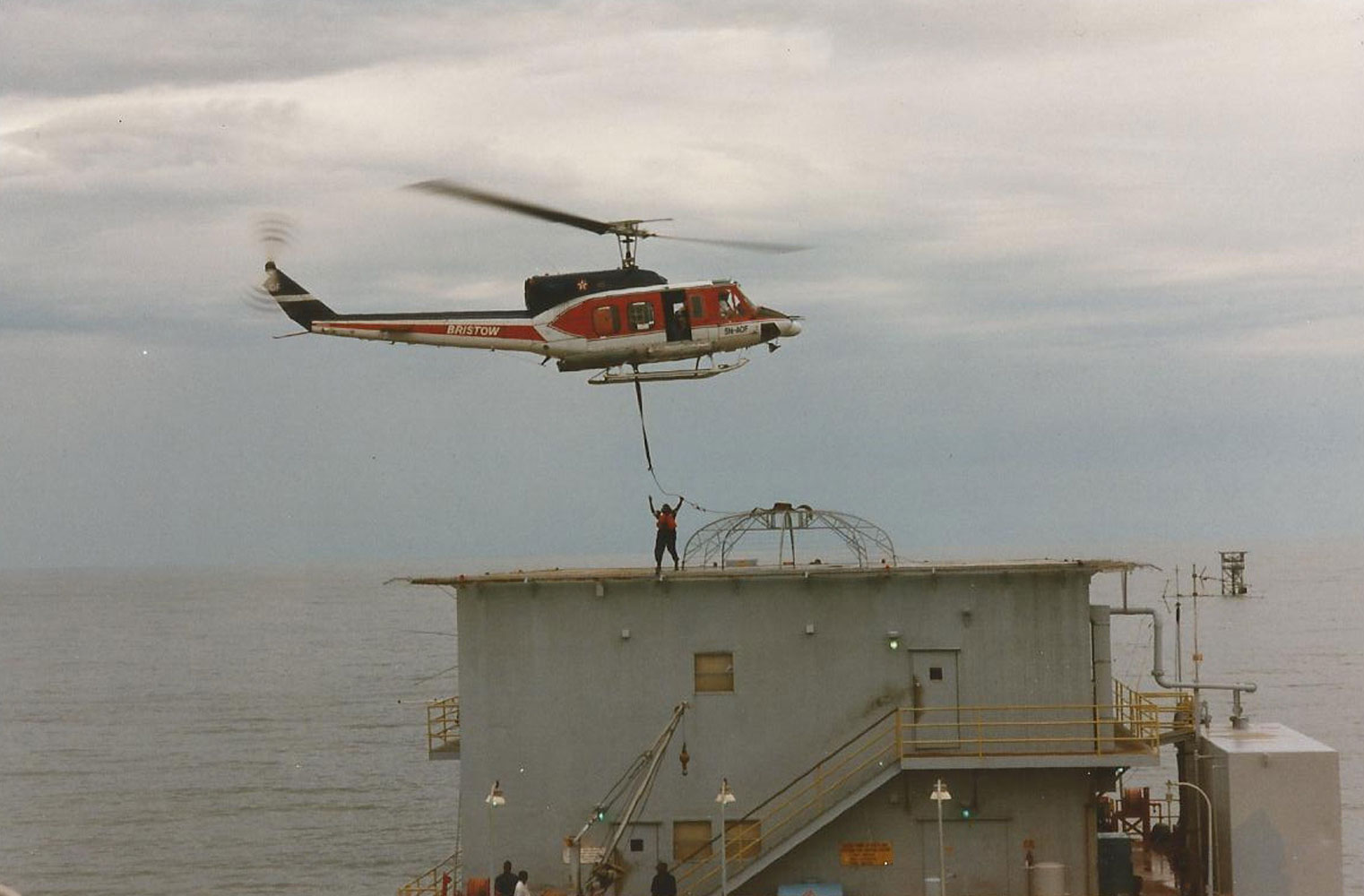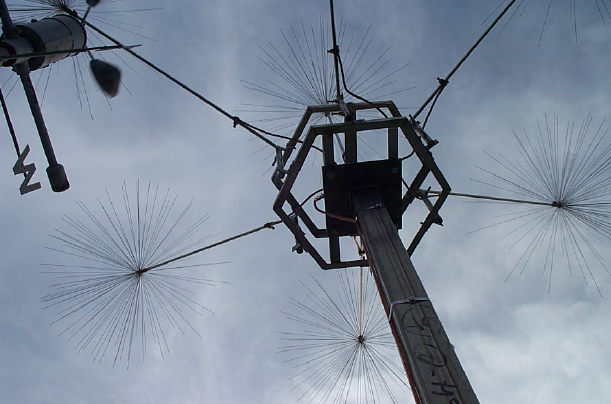RIGS & PLATFORMS
The Challenge
Lightning events are on the rise and are predicted to strike with more frequency, more often and more forcefully all over the world. Areas that have not experienced a large impact before will certainly be impacted in the future. This will leave many industries searching for more proactive solutions that provide greater safety and protection in order to prevent loss, damage and destruction. Offshore drilling companies are not immune to the potentially devastating effects. In fact, they may be at an even bigger risk than first thought. Even though lightning is less likely to strike over the open and deep water, the risks affecting a rig or platform are still great – and growing.
Offshore rigs and platforms are thought of as “grounded” to the ocean. However, the environment, and even the design of the facility itself, may lead to a compromise in bonding with rust and oil deposits that impede the energy’s path to ground. This leaves the advanced electrical and electronic systems and personnel susceptible to severe damage from not only direct strikes but dangerous secondary surge effects of lighting as well. Many upstream companies like Transocean, Chevron, Texaco, ExxonMobil and BP are trying to tackle the issue of how to stay online and not compromise productivity – or safety – during increased instances of bad weather. They are turning to Lightning Eliminators & Consultants (LEC) for the solution.
The Goal
- Assessing vulnerability to determine proper solutions
- Improving level of safety for the workforce
- Protecting vessels against direct strikes and secondary surges
- Reducing downtime and associated costs
- Extending facility life through preventative measures
When it comes to threatening the offshore community, thermodynamic processes typically start near shore and can evolve into open water events. It comes as an offshoot of global climate change. Rising temperatures around the globe are causing an increase in the frequency and severity of lightning strikes and creating a growing need for protection.
No company large or small is immune. They all have grasped the reality of needing to protect offshore systems from all types of dangerous weather. They look to LEC to provide consulting and solutions for rigs and platforms in the waters off the coasts of Africa, the Middle East and parts of Europe, Asia and Latin America. They are not alone in finding a greater need for protection. LEC has installed over 3,000 systems in more than 70 countries during the past 41 years, including recent work on offshore platforms in Mexico, Egypt, Nigeria, Malaysia and South Korea.
During 2012, solutions for nearly a dozen companies’ offshore platforms and rigs were produced following vulnerability studies based on IEC and NFPA guidelines and standards. Many included Lightning Eliminators & Consultants’ no-strike protection system to halt current -- and prevent future -- costly effects of a lightning strike. The Dissipation Array System (DAS) prevents lightning strikes in an “area of protection” by discouraging the attachment process of lightning, rather than attracting it to the area like older lightning rod systems that collect the strike were designed to do. LEC’s market-leading experience and knowledge has guided the evolution of the system, which retains a 99.87% reliability rate, leading the company to provide a unique no-strike guarantee.
It’s not just about direct strikes. Protecting sophisticated equipment – and significant investments – from secondary surges that wreak havoc on electrical instrumentation and equipment after the event is becoming a bigger topic in the energy production industry. With every upgrade in technology, sensitive systems like dynamic positioning (DP), drilling instrumentation and control and other rig management systems essential to staying online are becoming more vulnerable.
Determining the mean-time-between-failure (MTBF) for sensitive systems is a challenging task, much more difficult than simply calculating the raw dollars lost through obvious damage and downtime. As systems become smarter and more efficient, they are also more intricate and vulnerable. The voltage needed to run the instrumentation controls decreases and the risk of a high-energy secondary surge damaging equipment and affecting the operations on a rig or platform rises. In the end, it could cost $20,000 to $60,000 per hour or more when a system is down. And that does not include the replacement costs of the equipment affected.
Protecting a vessel from lightning strikes also protects the systems that would otherwise have lost a considerable part of their lifespans. With the uncertainty of the world economy, many companies look to LEC for its cost-effective protection as a way to extend the lives of older vessels and become more risk averse with new construction.
The Solution
Not every case is the same, so LEC starts with a risk assessment to determine the level of vulnerability the rig or platform faces. LEC engineers interview key rig/platform technical personnel, review schematics and wiring diagrams for crucial components and inspect in situ grounding practices.
LEC’s site surveys provide sound reasoning for the proposal offered, as each one is tailored to the needs of the rig or platform in question. Some rigs may only need surge protection devices (SPD), which have become critical to protecting power distribution and low voltage instrumentation and control. Other rigs and platforms may need a no-strike system to provide security against lightning strikes on the helipad, drill derrick or jack-up legs.
No matter the level of protection needed, Lightning Eliminators has proven to be the right choice for the solution. Some of the world’s largest offshore producers are utilizing LEC’s DAS no-strike protection -- which is the only system available with a “no-strike” guarantee – as well as surge protection systems to provide a critical safety net for their sophisticated instrumentation and their pocketbooks.
Education: The Lightning Protection Summit Series
Learn as much as you can: In May 2013 LEC launched its new educational series aptly named “The Lightning Protection Summit”, a program dedicated to educating industry on the science of lightning, how it works and how to protect against becoming another statistic of its wrath.
In October 2013, LEC will be holding its second of these events at the Monument Inn in the Houston Ship Channel for Petroleum and Chemical professionals. To learn more and register visit: THE 2nd LIGHTNING PROTECTION SUMMIT
After spending time with executives from the Oil and Gas, Petrochemical and Chemical industries in Houston the past fall at various events it became clear that although many companies understand that lightning is of course a threat, they did not know how much of one it is, and how comprehensive the damage can be. Although they knew lightning could strike, they were unaware of how often it does and that damage can occur not only from a direct strike, but from lightning’s secondary effects and that secondary damage can be in the millions. Due to the lack of knowledge they seemingly have about how lightning works and why it needs to be considered LEC designed this series understanding that many of the facilities represented were an accident waiting to happen.
Rig Summary Sheet
Location:
Countries: Cameroon, Nigeria, Gabon, Angola, Democratic Republic of Congo, Ghana and South Korea
Regions: West African oil fields: Gulf of Guinea (GGA); West Africa South (WAS), and Jubilee. Also Hyundai ship yard during construction of new rig.
Solution Type: 24 rigs total: Jack-Ups, Semi-Submersibles and Drill ships
Services Provided:
Consulting:
- Lightning strike vulnerability
- Primary and/or direct strike lightning protection and surge protection due to the secondary effects of lightning on instrumentation and control circuits – “Meantime - between - failure” solutions provided.
Note: Includes review of schematics and wiring diagrams of critical systems, inspection of grounding practices, photo documentation and interviews with key technical personnel
Solution recommended:
- Typical recommendations include the use of:
- Surge protection devices (SPDs) to be installed on
- Critical power generation and distribution equipment/circuits
- Critical instrumentation and control equipment/circuits
- Critical safety and security equipment/circuits
Note: All recommendations are based on the information gathered during the survey and are contained within proprietary reports. Each report is rig specific and, among other things, details the locations and circuits to be protected and their interface with the SPD. Further analysis regarding the compatibility of the products recommended and their installation is warranted and will require input from the customer.
Products Sold:
Consulting Services
Surge Protection Devices
Lightning Prevention Devices (SBIs, SBTs)
Platform Summary Overview (Other)
Locations: Countries: Malaysia, Mexico, Egypt, Nigeria, South Korea and USA
Regions: South China sea, Gulf of Mexico, Mediterranean Sea, Niger river delta in West Africa, unknown locations offshore. Also in port: South Korea, USA
Solution Type:
Jack-up drill rigs, production platforms, pipe laying ship, oil tankersServices Provided:
- Consulting in regard to lightning strike vulnerability; primary and/or direct strike lightning protection; surge protection due to the secondary effects of lightning on instrumentation and control circuits, risk assessment.
- Design of lightning protection systems using DAS, SBIs and SPD.
Solution recommended:
- Both no-strike and reduced risk protection systems were recommended and designed, depending on the customers’ requirements. Each entity required a separate analysis based on the customers’ goals for lightning protection.
- For DAS (no-strike) protection, DAS was distributed on the drill derrick, helipads, jack-up legs, telecomm masts and cranes.
- For SBI and IPG (reduced risk) protection, SBIs or IPGs were distributed on the drill derrick, helipads, jack-up legs, cranes and edges of different decks.
- Risk/Vulnerability studies included lightning protection recommendations based on IEC and NFPA guidelines and standards.
LEC partial list of projects for offshore platforms, rigs and vessels:
Barge 102 SBI Array
Barge 103 SBI Array
Jack-up rig - Prisa 112 SBI Array
Jack-up rig - Prisa 111 SBI Array
Marine Termnal Offshore production platform DAS (Helipad) Array
Elf Amenam PJT Oil Tanker IPG Array
Pemex EPC Production platform DAS (Helipad) Array
Sedco Forex Rig 710 Semi-Submersible SBI Array
Deep Blue Pipe Laying Vessel DAS Array
Drilling Rig SBI Array
Panna Production Platform, India DAS Arrays
DSME (Daewoo Shipbuilding & Marine Engineering); TOTAL Oil Production Vessel Lightning Safety Analysis
Jack Ryan Deepwater Millennium Sedco Energy & Sedco Express
For complete rig or platform protection and all your facilities lightning protection needs contact Lightning Eliminators & Consultants, Inc. at 00 +1 (303) 447-2828 to find out how to get comprehensive, tested and proven lightning protection for your company.
About Lightning Eliminators & Consultants (LEC) Lightning Eliminators & Consultants (LEC) is dedicated to providing integrated lightning protection and prevention products, solutions and services by utilizing innovative, patented charge transfer technology, grounding systems testing, surge protection design, and providing comprehensive consulting services based on physics and state-of-the-art engineering principles. Working in more than 70 countries and throughout the United States, LEC Global has implemented its proprietary DAS™ solutions in addition to RGA™ solutions for floating roof tanks across many industries like petrochemical, oil and gas, biochemical, information technologies, nuclear energy, utilities and manufacturing.
Products and Solution Links:





